PS 18 JULY 2023: I have gotten some feedback about the cover art, and some of these comments/criticism seem to involve a misunderstanding of the purpose of the game system. That is of course my fault. Above, I state the purpose as “remove all reference to the OGL 1.0a and any content that falls under it”. In this regard I think I was successful (but again if you see something that could somehow be attacked under copyright or other basis please let me know). However, my ultimate goal was to create an open source set of rules that can be used to play OSR type games by creative GMs looking for something to build adventures upon, and game designers to use to create their own games. So I did not pay a lot of attention to art or imagery. I just punched a few words into an AI art generator and picked the brightest colors available. The fact that some hate the cover art so much as to reject the content is a head scratcher for me, but since I did not intend it for commercial sale… oh well — I never claimed to be a good judge of art or style. Notwithstanding the cover art which many find offensive, I hope you find the rules useful.
Tag Archives: non-OGL
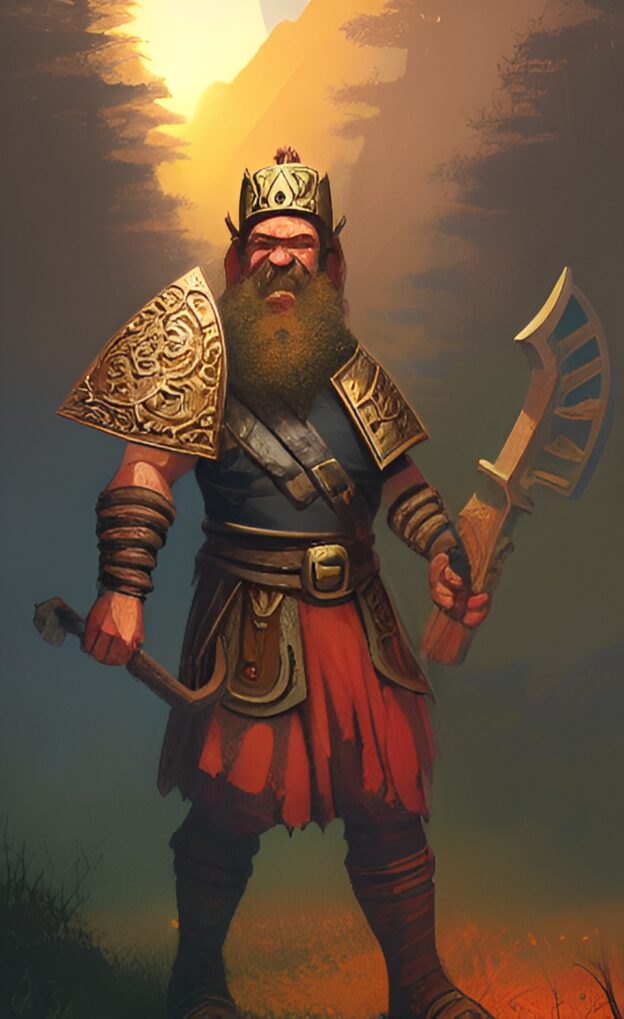
REVIEW: KOOKS 2d10 RPG Playtest
I recently ‘updated’ my home rules KOOKS system by changing the d20 system to a 2d10 system; along with other small changes. Tonight we did a one shot where the players were given very powerful 5th level Characters with very high level armor. They were to fight against a lot of lower level NPCs and a few higher level NPCs, but none that could be considered equals or superior.
The game was a route. The two high level Player Characters just waded through the masses of low level opposition and demolished them.
Why?
Because the 2d10 system creates a Bell Curve. It is very unlikely that anyone will roll a very high roll or a very low roll within their range of possibilities. With PCs that each had Defense Modifiers of 18+ it was just about impossible for a lower level NPC to hit them.
The first time I experimented with this idea was in a wargame I made called ‘C’est la Guerre‘ where instead of using a 1d6 I used 2d6 creating a bell curve of options. Two infantry units blasting away at each other with musketry were very unlikely to do anything more than cause low level incremental damage. Throw in some artillery and that damage gets higher but not overwhelming. It is at that point that you send in your cavalry to charge or some fresh infantry to do a bayonet attack. That was the only way of breaking those stubborn infantry units.
The two dice versus one changed the dynamic of the game tonight. The two powerful PCs dominated a group of 8 lower level guards and a higher level captain. Then when they confronted three enemies who were close to parity, but not equal, they had a bit of a fight on their hands. But again it was very difficult even for the bosses to hit the two PCs.
If I had wanted to create a real challenge, then I would have needed to add something much more powerful to the mix. Perhaps a ‘boss’ possessed by a high level demonic force? Or perhaps a magic user with access to very high level spells? Or an NPC with a very high level protector?
Something to think about.
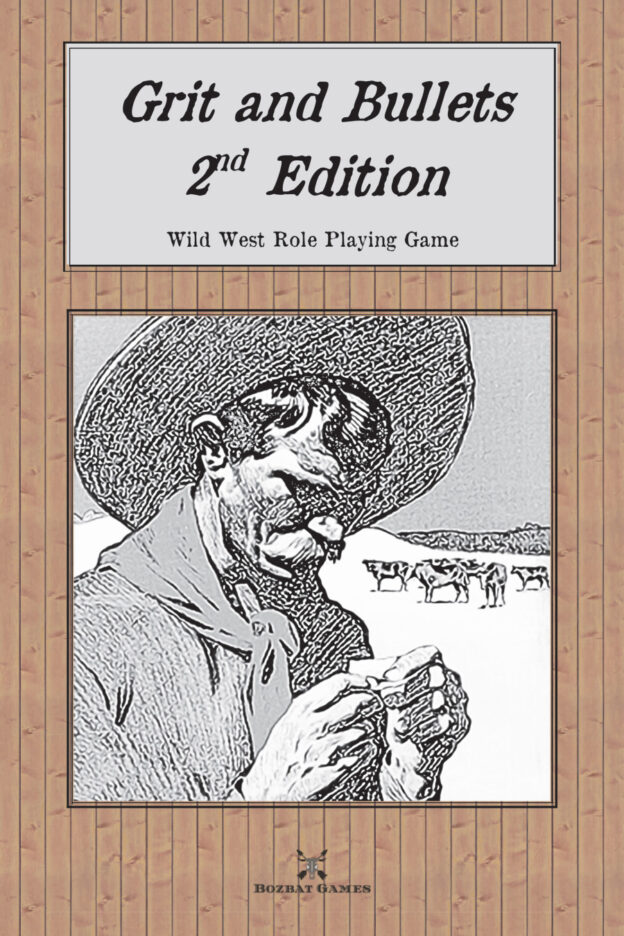
Grit and Bullets, 2nd Edit Now Released
The primary difference between the original and 2nd Edition is the removal of all ‘open game content’ as defined by the OGL 1.1 and the removal of the OGL 1.1 itself.
T.W.O. RPG is Finished!
T.W.O. RPG with the completion of the SPELLS & MAGIC ITEMS supplements is now done. The goal was to create a non-OGL set of light rules compatible with 3.5 stuff.
It is published under the most open Creative Commons license, so feel free to use it as you see fit. Comments and suggestions are of course welcome!

The Hobo Way
This set of rules started about the middle of 2022. An odd idea that formed into a completed project. I am rather proud of it. It combines some of my best ideas combined with a growing ability to format the book and come up with appealing art work.
One problem I had was that I made a number of different covers for The Hobo Way, but I could not decide which one I liked more.
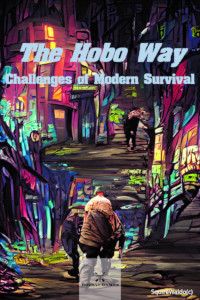
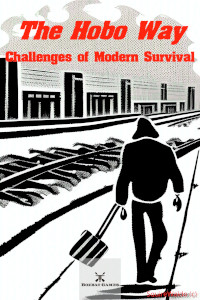
Which do you like more?
Small Survivors – 2nd Edit
What would you do if you suddenly became 2 cm tall?
In an alternate universe there is a galaxy very similar to our galaxy. In that galaxy there is a star very similar to our Sun. Circling that star is a planet very similar to our Earth. On that planet there are oceans, land masses, plants and animals very similar to what we find on Earth. Among those animals there is a very smart species of hominids very similar to humans.
And those hominids that are so very similar to us are governed in a very similar way.
Only on the other planet, unlike our Earth, the governments are mostly controlled by evil men and women who commit unspeakable crimes against the population of the planet. Yet the people of that planet are lazy, apathetic, and complacent. They are too obsessed with sports, entertainment, and consumerism to pay any attention to what the evil leaders of the planet are doing.
Of course this could never happen here on Earth.
On this similar planet in an alternate universe, the evil leaders hired mad scientists to create a deadly pandemic. Their goal was to kill the majority of the population of the planet so that the abundant resources would be entirely available to the elites and their loyal servants.
This is a game where a tiny percentage of the population in an alternate universe survived a sinister conspiracy aimed at killing 99% of the people living on the planet.
Your Character will be one of the Survivors who was not killed by the conspirators, and now must find a way to live in a harsh environment and then seek revenge against the leaders who betrayed you!
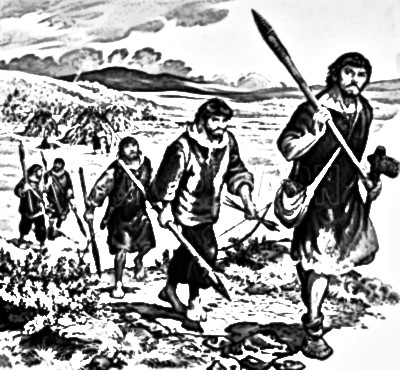
Released on ITCHIO: The Guardians of Bendor
This is an adventure designed to be played with Pulp Kharma.
It is a mash-up inspired by two famous science fiction franchises. One seems a bit like a Western in outer space, and the other seems a bit like a kung fu movie in outer space. When you look at the Character Cards at the end I think you are going to be able to figure it out.
The PCs of this adventure are the crew of a space ship named Tranquility. They are struck by a strange cosmic phenomenon that can at best be described as a “space storm”. The ship is sucked into a strange vortex. The instruments mostly stop working, and some are damaged beyond repair. Luckily the engine, artificial gravity, and the life support are fine.
And everything is quiet. As if nothing had ever happened. There is no sign of any “space storm”. And they are not where they were when the storm pulled them into the vortex.
As the adventure proceeds they discover they are in a very strange place indeed. There is a planet named Bendor inhabited by short hairy humanoids called Ezoks. And there are other familiar characters as well, some not so friendly.
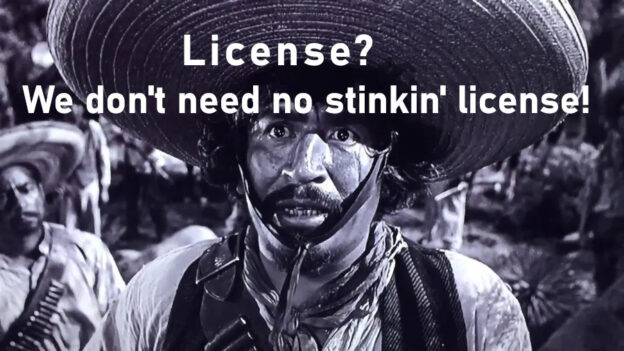
License? We don’t need no stinkin’ license!
There is a lot of confusion about Wizards of the Coast, Inc. (WotC) and the Open Game License (OGL). Some people seem to think that if you make a game that is in any way similar to products made by WotC, or some other game, you have to have permission, or a license to do so. Unlike the complex task of cutting hair, doing nails, fixing plumbing, etc., you do not need a license or permission to write games. I think that for most projects based upon the OSR or any project with game mechanics similar to other games, there is no need to use any OGL, license, or obtain any permission other than that required by the ‘fair use’ doctrine and common courtesy.
As I suggested in Is it OK to “steal” game rules or mechanics?, game rules generally cannot be protected, only the actual words and images (copyright), trademarks and tradenames, and occasionally patents for really unique processes and game items. So, unless you are just copying another source word-for-word, which is what the WotC OGL 1.0a allows you to do, you do not need to worry about copyright or getting permission or a license to use copyright protected content.
The ‘fair use’ doctrine does allow for the use of copyright protected material under limited circumstances:
Notwithstanding the provisions of sections 17 U.S.C. § 106 and 17 U.S.C. § 106A, the fair use of a copyrighted work, including such use by reproduction in copies or phonorecords or by any other means specified by that section, for purposes such as criticism, comment, news reporting, teaching (including multiple copies for classroom use), scholarship, or research, is not an infringement of copyright. In determining whether the use made of a work in any particular case is a fair use the factors to be considered shall include:
- the purpose and character of the use, including whether such use is of a commercial nature or is for nonprofit educational purposes;
- the nature of the copyrighted work;
- the amount and substantiality of the portion used in relation to the copyrighted work as a whole; and
- the effect of the use upon the potential market for or value of the copyrighted work.
The fact that a work is unpublished shall not itself bar a finding of fair use if such finding is made upon consideration of all the above factors.
17 U.S.C. § 107
In effect the ‘fair use’ doctrine allows for the word-for-word use of copyright protected material in limited circumstances and properly cited. Including brief properly cited quotes of someone else’s work is fine, including vast amounts of that work without the author’s permission may not be wise.
But remember, only the words are protected by copyright, not the mechanics, formulas, systems, processes, etc. If you take a set of rules and use the exact same mechanics, but you do not copy the text, images, trade name, or trademark then there is no violation of copyright, and you do not need any permission. Nor do you have to provide any attribution at all, but courtesy would suggest you do so.
It is possible that certain unique process ‘tech’ used in a game might be protected under patent law for some ‘process patents’, whether those ‘processes’ are filed or not. However, such ‘process patents’ have a very limited time period for protection (20 years at most) after which they become part of the public domain. Such ‘process patents’ can also be abandoned by the maker if others use the process and the maker does not legally defend it within the statutory period of limitations to bring suit.
The OGL 1.0a created by WotC allowed the user to copy specific protected content word-for-word as long as you followed the terms of the license, which is more strict in some ways than traditional copyright law, trademark and tradename law, patent law, etc.
If you are not copying word-for-word from protected content, using the tradename or trademark of another author, or using mechanics, formulas, or other game systems that are currently protected under patent law (very unlikely), there is no reason to use ANY licensing system.
DISCLAIMER: Nothing in this article is being provided as legal advice or a substitute for legal representation. I am not your lawyer.
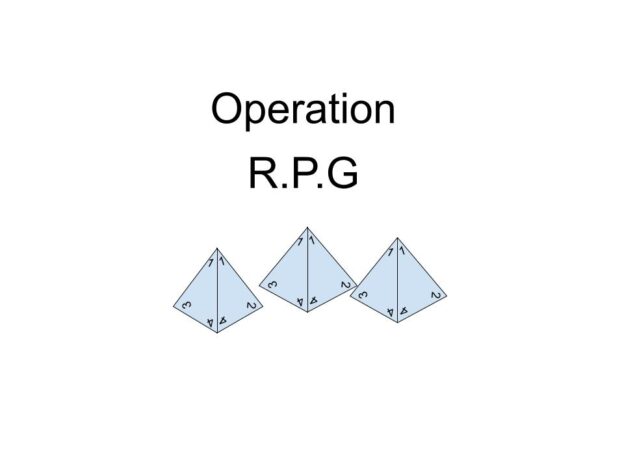
REVIEW — OPERATION: R.P.G.
I recently downloaded this free game at: https://noxicus.itch.io/operation-rpg
This is a very interesting concept for a game. For all the noise and fury over the WotC OGL, this little game has scooted right past since it is not in any way related to WotC et al. How refreshing!
‘OPERATION: R.P.G.’ is a clever little game that relies upon a dice pool of four sided dice (d4s). There are nine (9) attributes:
strong, stuff, sneak, speak, smash, smart, stab, stunt, and sense
You assign the following dice for your character:
- assign 3 dice to one attribute,
- assign 2 dice to two attributes, and
- assign 1 die to three attributes.
The rest get zero. You then create a ‘unique item’. Voila, you are done.
The play mechanic seems very similar to Dungeon World. It would seem that the Game Master never does any rolling, but instead presents situations and asks, “What are you going to do?” Perhaps the GM also presents some options. “Olaf tries to punch you; do you dodge trying to avoid the punch, or do you block and then counter punch?” Caveat — I think that is how it is supposed to go, and that is how I would proceed as GM; but as you can see from the use of ‘seems’ ‘seem’ and ‘perhaps’ — it is not that clear to me.
The situation is resolved by selecting an appropriate attribute for the action, the GM picks another attribute (I must admit I don’t exactly understand this part), and then roll all the dice and pick the highest one. If the attribute in question is 0 then you roll 2 dice and take the lowest. 4 is an Absolute Success, 3 is a Partial Success, 2 is a Partial Failure, and 1 is an Absolute Failure. Good things happen when you roll a 4, and bad things happen when you roll a 1.
There is also an issue of Stress. You can use Stress to push your Character — you get an extra die, or you can use Stress to perform other tricks.
I like this game and I want to try it out!
I only have one complaint, and it involves one of my pet peeves: I like ‘Lite’ RPGs, but not so ‘lite’ that I don’t understand what is going on. Sometimes a creator is so set on making the game sleek and streamlined that it ends up a little confusing, at least to me.
For instance, in this game there are a few things I found a bit confusing:
- I had to read the paragraph about assigning dice for character creation a number of times before I understood it, but perhaps I am just not that smart?
- What exactly is a ‘unique item’, and how do I create one?
- What does “Your game master will pick another…” mean in regards to the outcome rolls?
- Is the Task Resolution really like Dungeon World or was I just filling in the gaps incorrectly?
- How do the Characters advance?
Those are some pretty serious questions, and I think the rules should explain them in some detail. I will send a message to the creator and ask for clarification.
All in all I like the game. If I get the answers great, if I don’t I will improvise.
Enjoy!
RESPONSES TO MY QUESTIONS (27 JAN 2023):
“What exactly is a ‘unique item’, and how do I create one?”
In this case, a ‘unique item’ is a piece of equipment that you think your character would own, use, and have customized. For example, a getaway driver might have a fast car with nos capabilities, and a safe cracker might have an automatic lock picking device of some sort. In essence, a unique item is a piece of gear that reinforces the sort of character that you want to play. As for making one, it’s simply a matter of thinking up an item that you think your character would have, and proposing it to your GM. If they approve, it’s an item that you can always call on in the fiction to do things that you might not be able to do otherwise, as long as you would be able to reasonably do so (I.E. you have the item with you in the fiction). If they don’t approve of the item, you’ll have to think up a new item for your character and propose that one instead.
“What does “Your game master will pick another…” mean in regards to the outcome rolls?”
So, this is my favorite part of my rendition of the Caltrop Core system. The idea is that when you go to roll the dice, the player starts by saying what they want to roll with, a la Blades in the Dark. Then, the GM picks an additional attribute. Then, you combine the pools of the two attributes chosen, and roll that many dice.
For example: say I’m trying to hack a computer without setting off any alarms. I have a Smart of 2, so naturally, I want to use Smart for the roll. My GM sees that I’m trying to something without being noticed (in this case, by the alarm system of the computer), and picks Sneak, which I have a 1 in. Then, I combine the two attributes that were picked, bringing me to a total pool of 3 dice, which I now roll.
“Is the Task Resolution really like Dungeon World or was I just filling in the gaps incorrectly?”
Yeah. It’s built on the Caltrop Core engine, which has a system for different levels of success built in, similarly to PBTA games like Dungeon World.
“How do the Characters advance?”
Well, the only built in method of advancement in Operation R.P.G. is the increase in maximum stress that happens as you complete missions/adventures. I plan to make a second edition sometime, and expand on the rules, maybe even add a violence engine built on Caltrop Core EX. My current idea for an official advancement system has to do with coming up with an experience system based on having your character do cool stuff, then spending experience to get mostly narrative advancements (such as additional pieces of unique gear, gaining contacts, and the like), with the possibility of occasionally increasing your character’s attributes.
‘T.W.O. RPG – Rules’ Now Published
The game is now on ITCHIO, LULU, and AMAZON.
Here is a set of rules I came up with in an effort to remove all reference to the OGL 1.0a and any content that falls under it.
I have a problem with rules so bloated that no one can figure out what anything means without a ouija board. I also dislike rules that are so ‘lite’ that they leave out important parts that are required to make the game playable. T.W.O. RPG is intended to be a ‘lite’ yet complete set of rules.
This is just the Rules. I am working on additional sections: Wealth Weapons Equipment, Monsters, and Spells. Coming Soon!